Dayton 7270100 Indoor Bike Computer User Manual
Dayton Industrial Co., Ltd. Indoor Bike Computer
Dayton >
User Manual
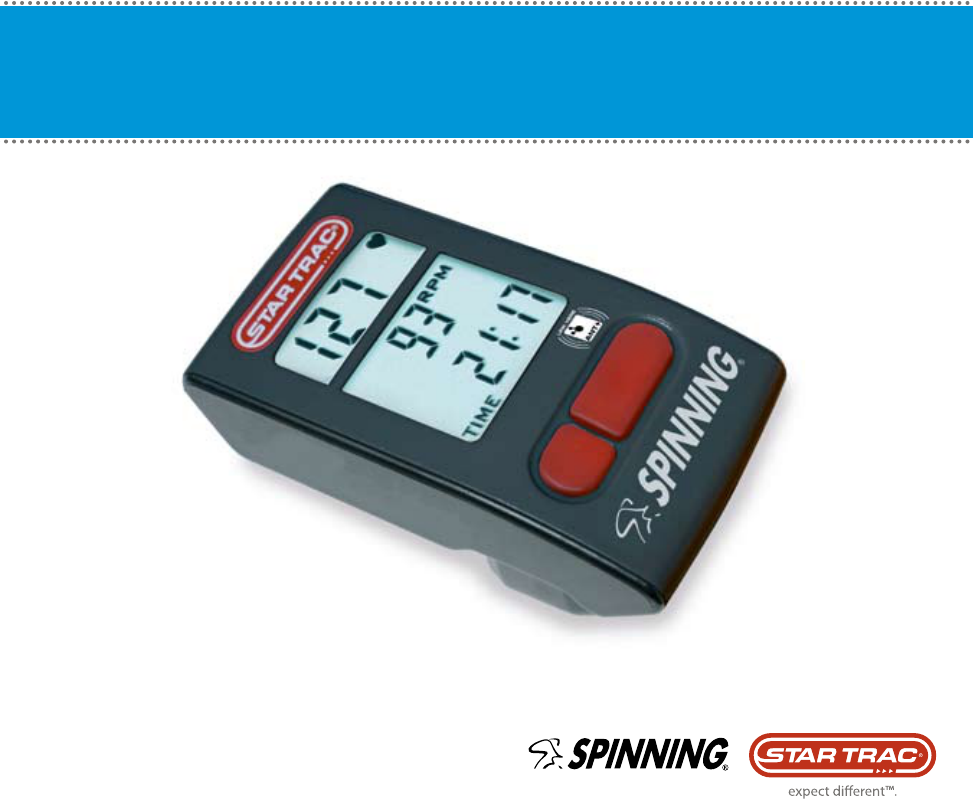
Spinning® Computer
User Manual
Installation, Service and Instructor Education


01
02
03
05
06
07
08
10
11
12
15
18
19
20
21
22
23
25
FCC Regulatory Statements
Parts List
Marketing Statement Regarding Heart Rate
Specifications
How it Works
Computer Window and Buttons
Installing or Replacing Batteries
Do I need to Re-sync?
Testing for RPM
Syncing Mode
Setup Mode
Installation of Cadence Sensor and Magnet – All Spinners®
Mounting Computer On Handlebars - Spinner® V
Mounting Computer On Handlebars - Sport / Fit / Elite
Mounting Computer On Handlebars - Pro 7070 / Elite 7080 / NXT 7090
Maintenance Checklist
FAQ’s and Troubleshooting
Spinning® Instructor Education
Table of Contents

FCC Regulatory Statements
1. This device complies with Part 15 of the FCC Rules. Operation is subject to the following two
conditions: (1) this device may not cause harmful interference, and (2) this device must accept
any interference received, including interference that may cause undesired operation.
2. Changes or modifications not expressly approved by Star Trac could void the user’s authority to
operate the equipment.
1
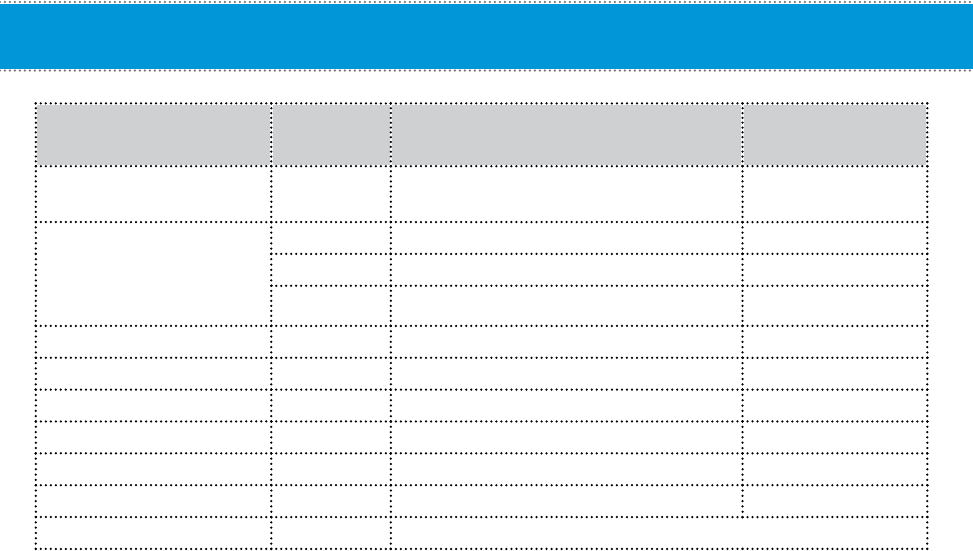
Parts List
Part Number for
re-order
Quantity Description
727-0100 Spinning®
Computer Kit
1 Spinning® Computer
727-0093-KT Mounting
Bracket Kit
1 Mounting Bracket
1 Spinner® V Mounting Bracket Insert
1 Mounting Insert for open handlebars
727-0084-KT 1 Cadence Sensor
727-0094 1 Cadence Magnet
N/A 1 AA Panasonic Batteries
N/A 1 Spinning® Computer Manual
N/A 1 M5 Allen Assembly Tool
N/A 1 M2 Allen Assembly Tool
N/A 1 M6x30 Computer Clamp Screw for Rhino Horn
Before installing the Spinning® Computer, verify that all the parts needed for mounting on your bikes
are included. If any of the items are missing, call StarTrac at 800-503-1221 or 1-714-669-1660 to
order a replacement kit.
2

Marketing Statement Regarding Heart Rate
Marketing Statement Regarding Heart Rate Acquisition on the Star Trac Spinning® Computer:
Star Trac takes the acquisition and accuracy of heart rate very seriously and has developed a system to perform
to the best ability that technology will allow. Star Trac has engineered a product that has taken every precaution
possible to acquire an accurate heart rate signal as well as eliminate “crosstalk” interference that may be
caused by other monitors being placed too close together.
To achieve the best possible results from your Spinning® Computer, please abide by the following important
parameters:
1) Users must wear either a Coded Transmitters (such as Polar© T61, Polar© T31C or Polar© WearLink®)
or an Ant+ compatible transmitter when operating the Spinner® bike with the Spinning® Computer. Only will
the Transmitter allow a “one to one” relationship with the Spinning® Computer and will minimize potential
“crosstalk” interference. If users wear non-coded straps, there is significantly increased potential for
“crosstalk” which will cause erratic heart rate display, loss of heart rate display and significantly reduce the
consistency of accurate heart rate reporting.
2) Bikes should be spaced so that the side-to-side distance from the Spinning® Computer on one bike and the
Spinning® Computer on bikes to the left or right is at least 36 inches (91.4 cm). In addition, the distance from
the bottom of the Spinning® Computer on one bike to the seat of the bike in front of it (where another rider
and his her transmitter would be seated) should be at least 24 inches (61 cm) in order to significantly reduce
chances for interference. See the diagram on page 5 regarding bike layout.
3
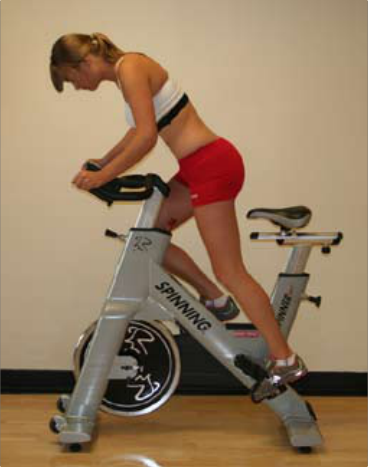
3) In order for the computer to display the user’s heart rate
the riders must lean into the display (within 10 inches) during
the first 30 seconds of the ride. and wait for the HR to
display. During this time the computer creates a one to one
relationship with the rider’s heart rate strap and this insures
that no outside signals will interfere with the riders data once
they return to their seated position.
4) Calorie calculations are displayed as a summary only.
5) Cell phones, televisions, speakers and other electronic
devices can cause interference with the operation if they
are in close proximity to the Spinning® Computer and/or
transmitter.
If there are any questions regarding operation or usage of
the Spinning® Computer, please contact Star Trac Customer
Support at 800-503-1221 or 1-714-669-1660.
4
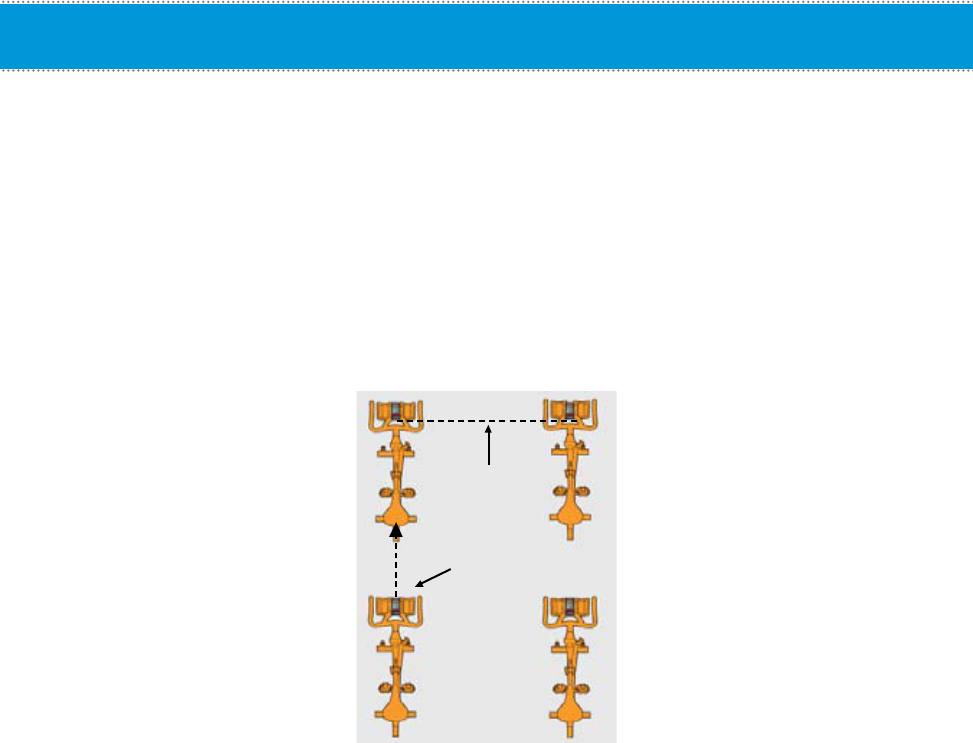
Specifications
Computer:
Heart Rate Range:
Battery:
Battery life expectancy:
Cadence Sensor:
Battery:
Battery life expectancy:
Distance to magnet:
Approximately 30” from computer to users HR chest strap
Qty 4 each AA Alkaline
1 year (depending on use and backlight usage)
Lithium CR2032
Approximately 1 year in a commercial enviornment (depending on use)
Approximately 5mm
5
At least 36
inches (91.4 cm)
At least 24
inches (61 cm)
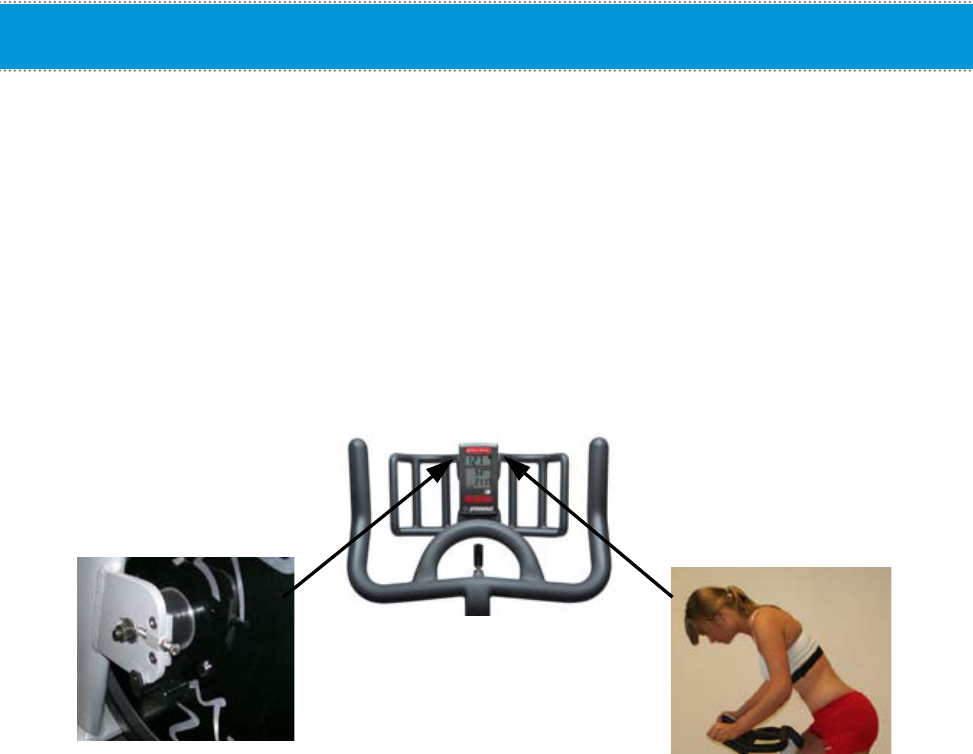
How it Works
How does the Spinning® computer work?
The Spinning® computer displays heart rate, RPM (speed), total distance and elapsed time.
• The heart rate information is received from an Ant+ or Polar® compatible heart rate strap worn by the
person riding the Spinning® Bike. The HR strap sends a radio signal to the computer and the computer
displays the person’s heart rate. If any other strap is used it will not display the heart rate. The computer and
heart rate strap must be within range of each other and no other heart rate strap can be within this imaginary
circle. The range is approximately 30 inches from the computer.
•The RPM signal is transmitted by the cadence sensor sending the RPM to the computer. Each time the
magnet on the flywheel passes the cadence sensor it records one revolution and as it counts the revolutions
it sends this number to the computer.
6
RPM Heart rate
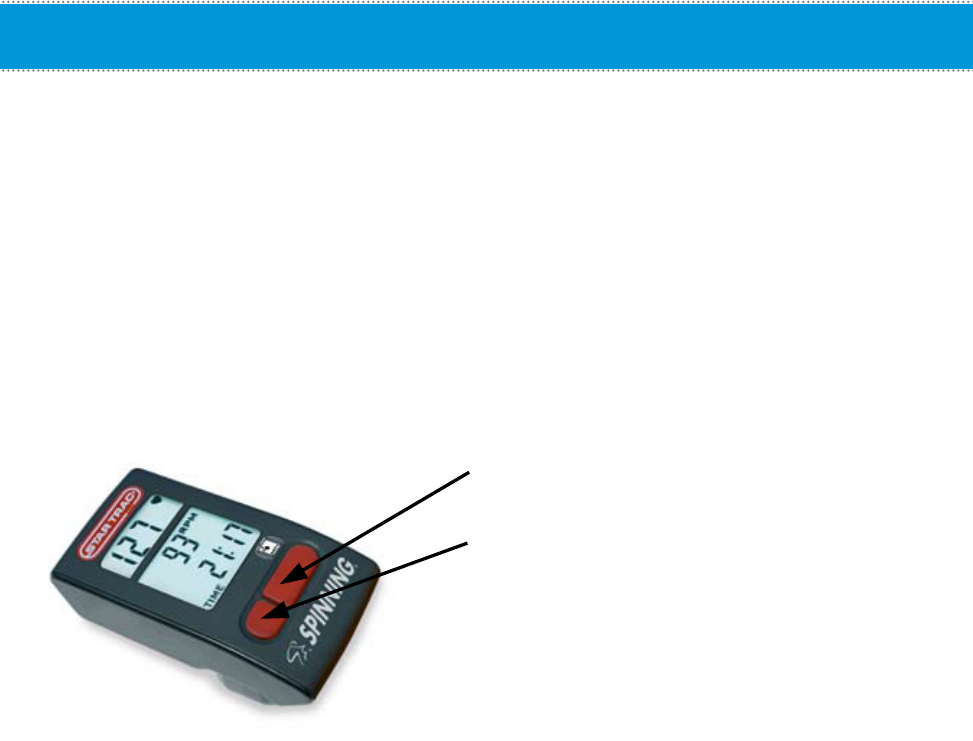
Computer Window and Buttons
Start pedaling then press any button to turn on the Spinning® Computer; the following data
will be displayed:
HR- Displays the Heart Rate of the user when wearing a compatible Polar® HR telemetry strap in beats
per minute.
RPM- Shows the pedaling speed of the user in revolutions per minute.
Total Distance- Distance measured in miles or kilometers depending on the setup selection.
Elapsed Time – The length of time in minutes from the time the computer has been activated or reset.
Buttons:
Toggle (right) button - Toggles between: Total Distance
and Elapsed Time.
Light (left) button - Turns on the backlight to enable
viewing in low light settings.
7

Installing or Replacing Console Batteries
Time required:
• 5 Minutes
Parts required:
• 4 new AA alkaline batteries
Tools required:
• Slotted or Phillips screwdriver
NOTE: The batteries in the computer will last approximately
1 year depending on usage. The cadence sensor battery will
last approximately 1 year.
1. Remove the computer from the handlebar or computer mounting bracket.
2. Loosen the captive screw on the back of the battery cover (screw will not
completely come off, it will remain captive.) To remove the cover, pull on the
captive screw and lift.
3. Install 4 new batteries. Note: Replace all 4 batteries at the same time.
Low Battery
Indicator
8
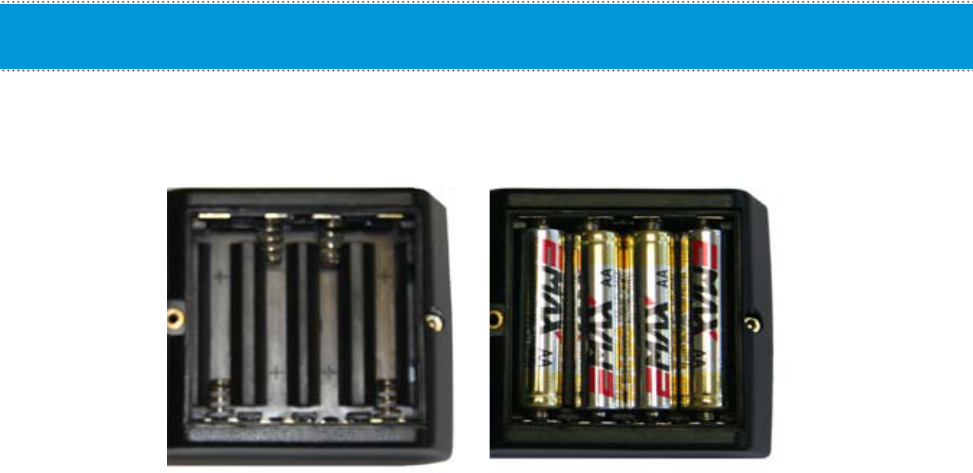
Installing or Replacing Batteries – cont’d
4. Note the directions each battery is to be installed. There is a plus (+) and minus (-) symbol inside the
battery compartment. The + sign indicates the positive (+) side on the battery and the - indicates the
negative (-) side on the battery.
5. Insert each of the 4 batteries into the battery compartment of the computer.
6. Attach the battery cover and tighten the screw.
7. Attach the computer onto the handlebar or computer mounting bracket and test.
9
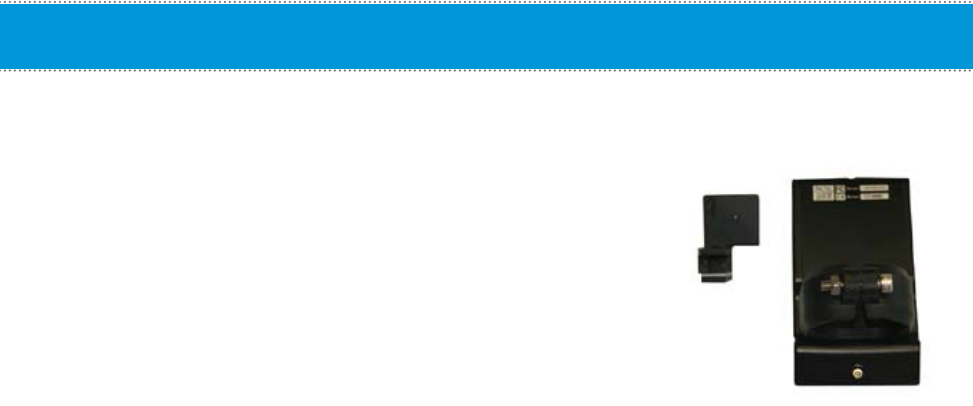
Do I need to Re-sync?
NOTE: Syncing will not improve Heart Rate and is not a calibration it should only be used to Sync (Pair up) the
cadence sensor and the computer so that RPM can be transmitted.
Perform the Syncing process after checking all of the following:
• Is the battery secure in the cadence sensor and the cover is not loose?
o A loose battery will prevent the cadence sensor to transmit
the RPM signal to the computer.
• Is the magnet aligned with the cadence sensor?
o A missing magnet or one that is not lined up properly will prevent the
cadence sensor to transmit the RPM signal to the computer.
• Does the computer turn on when you press a button?
o If the computer does not turn on replace the batteries in the computer.
• The computer turns on but as you pedal it does not show the RPM.
o If you have performed all of the above steps you may now sync the computer and cadence sensor.
This will make them a paired set and will be able to transmit and receive the RPM signal.
10
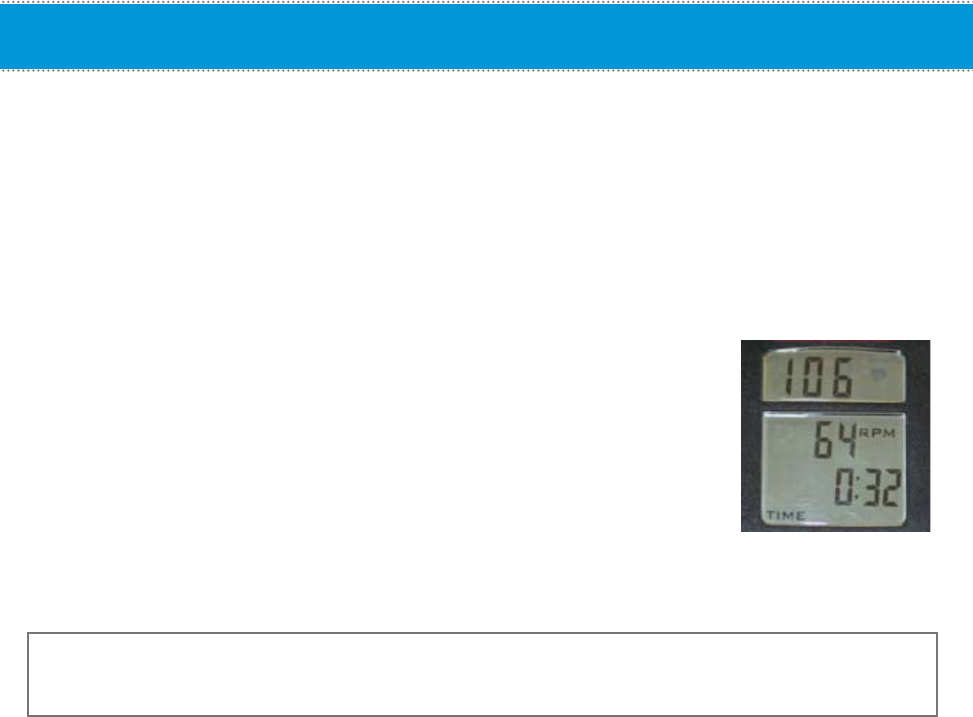
Time required:
• Less then 5 Minutes
Parts required:
• N/A
Tools required:
• N/A
TEST Procedure:
1. Once the batteries are installed, press any button and the display window will turn on in the
Workout mode.
2. Test by waving a magnet across the cadence sensor. If you see RPM
values, then the cadence sensor and computer are synced successfully,
there is no need to perform the sync process.
3. If you do not get any rpm reading and the computer turns off you WILL
need to perform the Syncing process.
NOTE: If the cadence sensor and computer are no longer a pair (i.e. when users swap handlebars with the
computer attached.) the Cadence sensor and computer will have to be sync’d again. Do not swap handlebars.
CAUTION: TEST ONE BIKE AT A TIME, the range for the cadence sensor is approximately 30 feet and
if you are testing the bike and someone else on the same room is pedaling another bike you may be picking up
the wrong RPM signal.
Testing for RPM
11
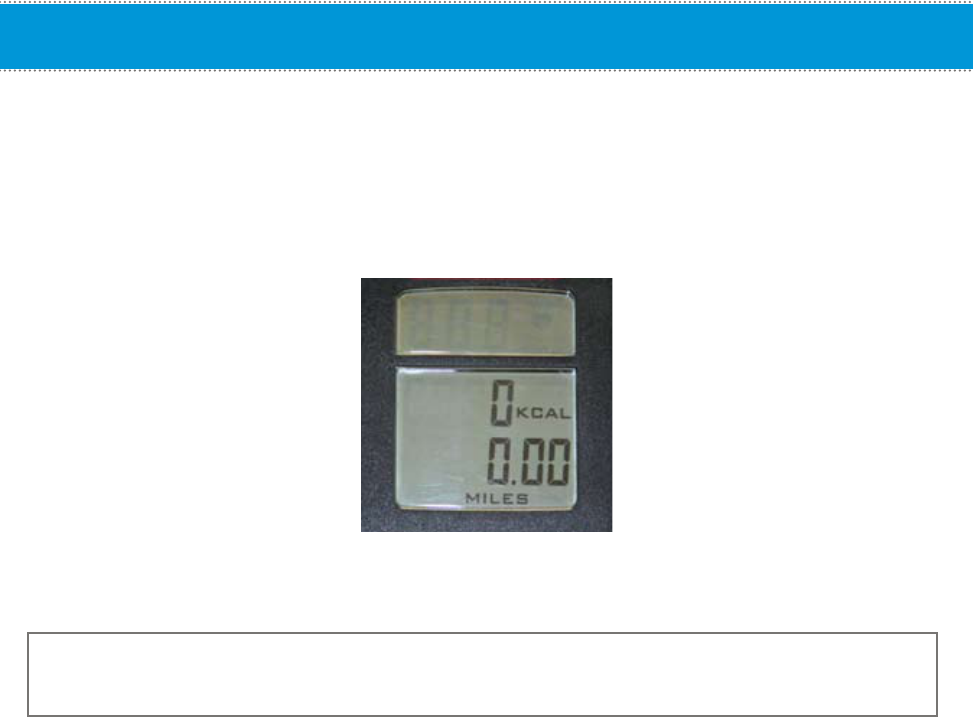
Syncing Process:
Time required:
• 30 seconds
Steps to Syncing:
1. Turn on computer and boot up to workout mode.
Workout Mode window
CAUTION: SYNC ONE BIKE AT A TIME the range for the cadence sensor is approximately 30 feet and
if you are testing the bike and someone else on the same room is pedaling another bike you may be picking up
the wrong RPM signal.
Syncing Mode
12
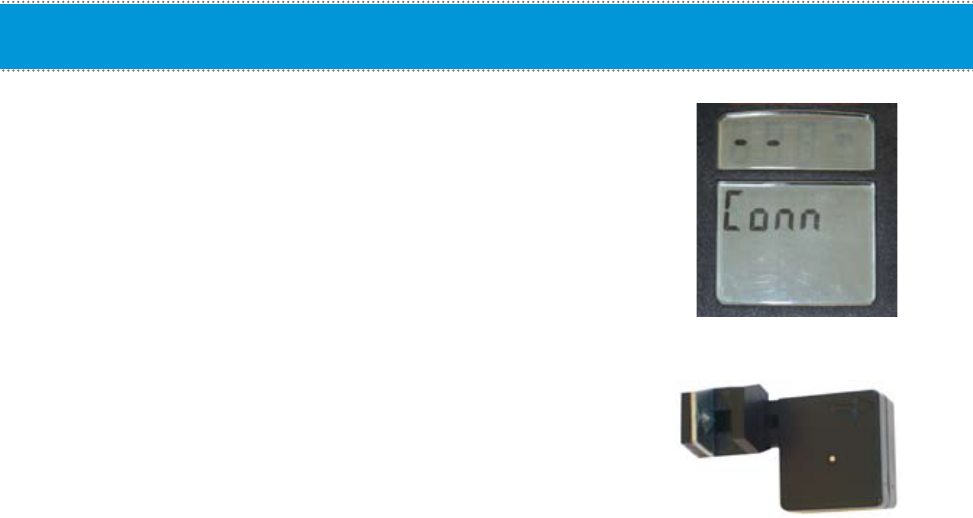
Syncing Process - cont’d
13
2. Activate Sync Mode on the computer by holding down the Light and Toggle
buttons for 6 seconds until the window displays “Conn“
3. Press the button on top of the cadence model.
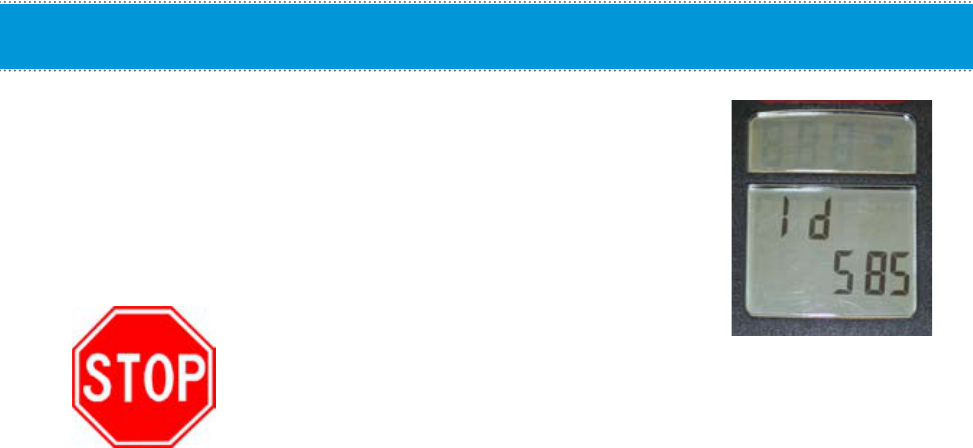
4. The red light on the cadence sensor will flash identifying that the cadence sensor
is good and has entered pairing mode.
5. The syncing process is complete when the window on the computer displays a
random ID number (e.g. ID123).
6. The computer will then automatically reboot.
Wait for 5 seconds.
You must wait for 5 seconds to allow the computer to reset the ID properly.
7. Test for response by turning the computer on then waving a magnet across the cadence sensor. By doing
this you are simulating the same motion as when the flywheel rotates and the magnet passes by the
cadence sensor. If you see RPM displayed, then the cadence sensor and computer were synced
successfully. Proceed with the installation and mounting to the bike.
NOTE: Remember to keep the computer and cadence sensor as a set at all times.
Syncing Process - cont’d
14
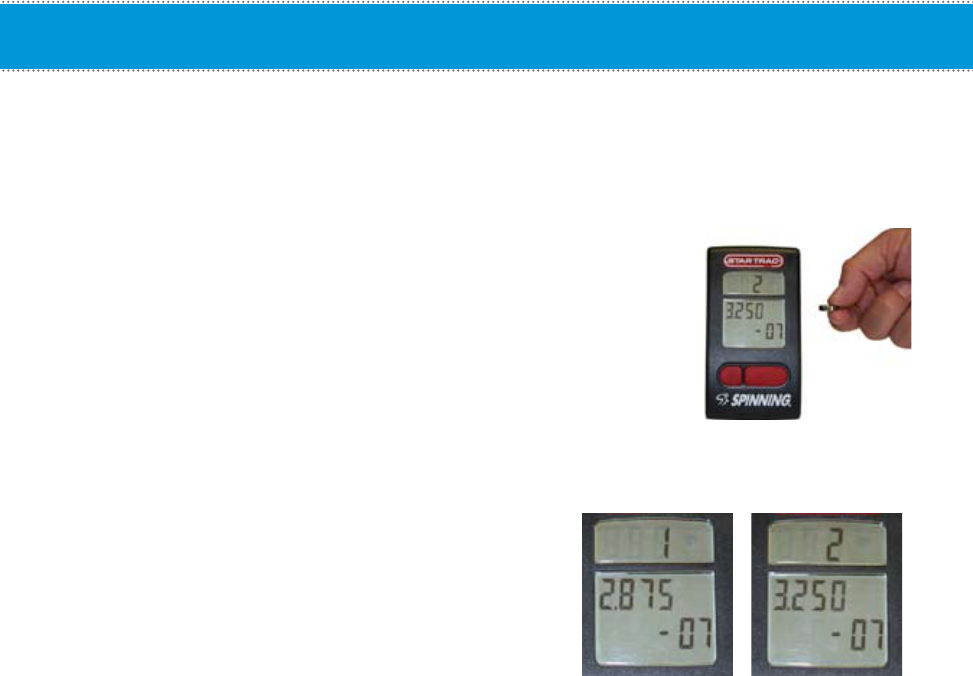
Your Spinning® Computer is pre-set with a gear ratio of 3.25:1 and a setting display distance in miles. It is also
pre-set with recommended default settings for the length of time the backlight will stay on when activated
and the length of time summary information will be displayed. You can make changes to these settings by
following the steps below. Any time you want to change setting or view information, follow these Setup Mode
steps again.
To activate Setup Mode:
1. Press any button to activate computer.
2. Wave a magnet along the right side of the Spinning® Computer
until the display window shows all LCD segments flash.
3. Press Toggle (right) button to scroll through available setup options.
4. Press the Light (left) button to change settings on the current display option.
Setup Mode options:
• GEAR and Software Version
o Gear Ratio, Select 1 (2.875) for V-Bikes, V2
and Spinner® V
o Select 2 (3.250) for all other models.
o Software Version displayed (-XX)
NOTE: User will not get the correct RPM values if the Gear
Ratio setting is not correct.
Setup Mode
15
(Default Setting)
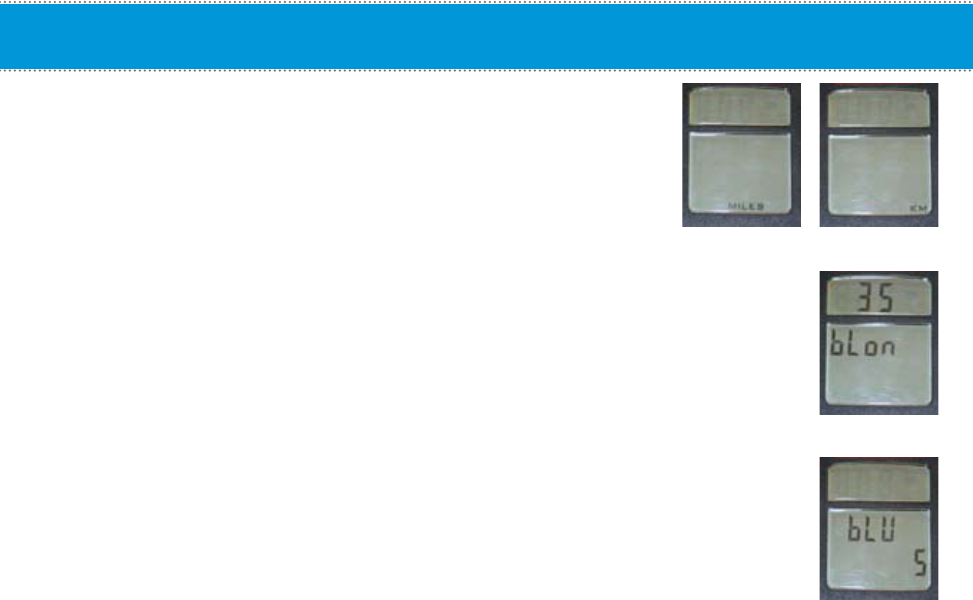
• Units - MILES or KM
Note: User will not get the correct distance values if
the Gear Ratio setting is not correct.
• BLON – (Default Back Light On*) The amount of time the backlight
will stay on when the left button is pressed. Select between 1
second to 60 seconds using the Light (left) button and press the
Toggle (right) button to save and advance to the next setting.
*Note: Increasing the BLON (Back Light On) time will reduce
overall battery life. A shorter BLON time will result in longer
battery life (recommended).
• BLU – (Back Light Usage) Total time in minutes that the back light has
been on since the last data clearing. Press the Light (left) button to
clear data, if desired, then press Toggle (right) button to accept and
advance to the next setting.
Setup Mode - cont’d
16
(Default Setting)
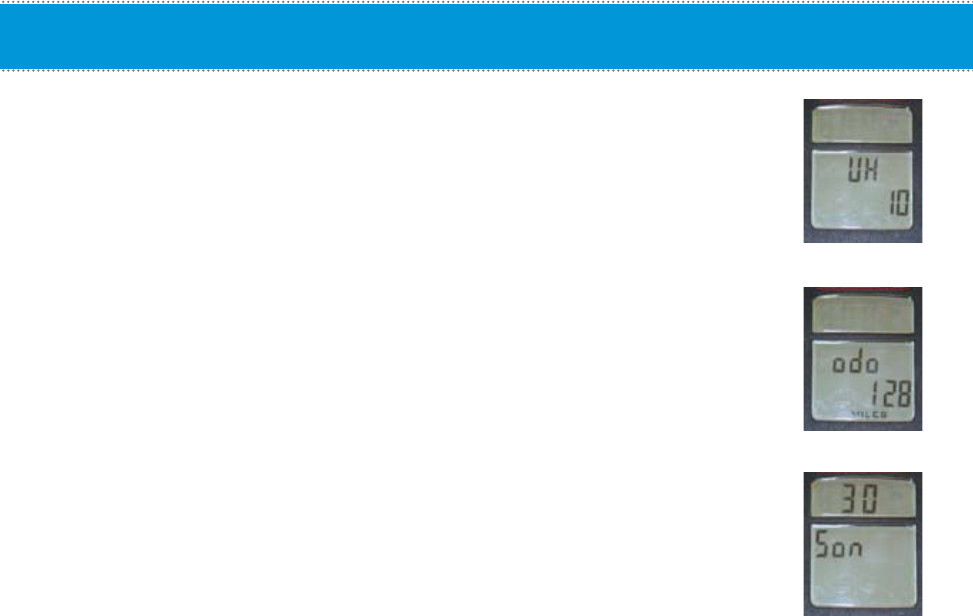
• UH – (Usage Hours) Total operation time in hours of display since the last
data clearing. Press the Light (left) button to clear data, if desired, then
press Toggle (right) button to accept and advance to the next setting.
o Usage hours should be reset during battery replacement.
• ODO – Total Miles / KM
Total traveled distance in miles or KM since the last data clearing.
Press the Light (left) button to clear data, if desired then press the
Toggle (right) button to accept and advance to the next setting.
• SON – (Summary ON Time) Number of seconds the summary will be
displayed at the end of the workout.
o Options: 30, 60, 90, or 120 seconds
Select by using the Light (left) button and press the Toggle
(right) button to accept and exit Setup Mode.
5. To exit Setup Mode, press the Toggle (right) button several times until the computer returns
to Workout Mode.
6. Once out of Setup Mode and in the Workout Mode, the computer is ready for use.
Setup - cont’d Installation of Cadence Sensor and Magnet – All Spinners®
17
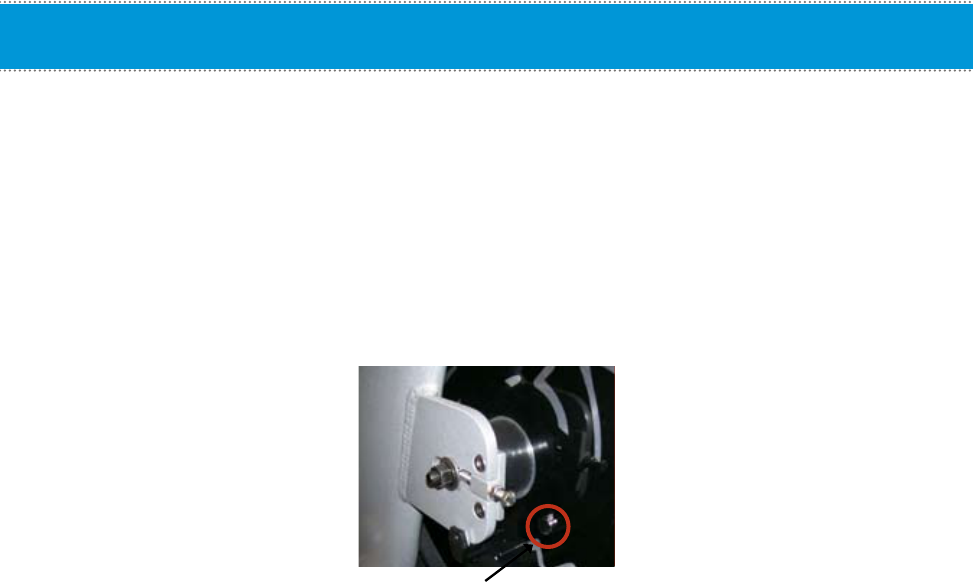
1. Before the cadence sensor is securely fastened to the flywheel support, it must be adjusted so that it is
about 5 mm (.20 in) from the magnet face. Install the magnet on the flywheel so that it aligns with the arrow
on the end of the cadence sensor. Note the distance between the end of the cadence sensor and the
magnet face. Remove the cadence bracket and adjust the distance by pulling or pushing the cadence
sensor bracket.
2. Tighten the set screw on the cadence mounting bracket using the M2 Allen tool
CAUTION
Do not over tighten the set screw.
3. Remove the backing of the adhesive on the magnet. Mount the magnet with the adhesive tape side onto
the flywheel by positioning the magnet so it will line up in front of the cadence sensor as the flywheel turns.
NOTE: Mount the magnet near one of the dots of the Spinning® logo as shown in the figure above.
Installation of Cadence Sensor and Magnet – All Spinners®
18
Magnet Location
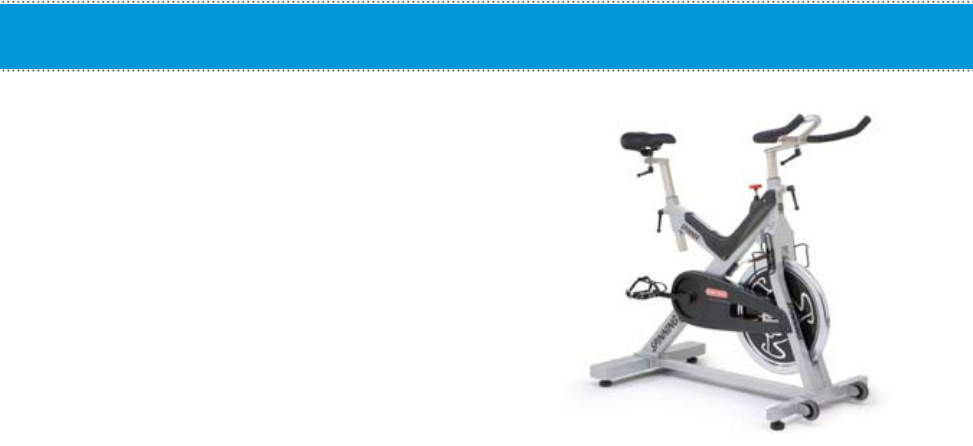
Time required:
• 15 Minutes
Parts required:
• 727-0100 Spinning® Computer Kit
NOTE: The thick insert is used on the V-Bikes
Tools required:
• M5 Allen Wrench
• M2 Allen Wrench
1. Place the thick insert inside the bottom part of the
Mounting Bracket Clamp. Position the mounting
bracket onto the center-curved portion of the
handlebars. Once positioned correctly, tighten the
4 M6x20 screws using the M5 Allen tool.
2. Install the computer onto the mounting bracket by sliding the computer clamp over the long portion
of the bracket. Tighten computer clamp with the M6 screw and nut using the M5 Allen tool.
NOTE: Use the M6x30 screw for the computer clamp when installing onto the computer mounting bracket.
This setup is also used on the V-Bike and V2.
Mounting Computer On Handlebars - Spinner® VMounting Computer On Handlebars - Sport / Fit / Velo
19
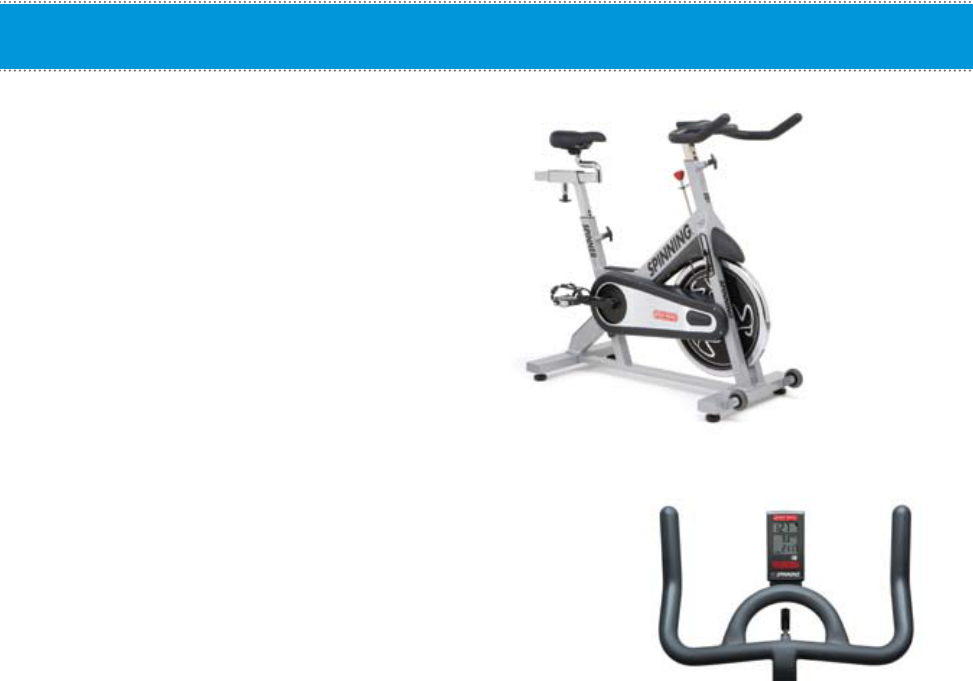
Time required:
•15 Minutes
Parts required:
• 727-0100 Spinning® Computer Kit
NOTE: The thin spacer is used on
Pro 5800 / 6800 / and Elite 5900 bikes.
Tools required:
• M5 Allen Wrench
• M2 Allen Wrench
1. Place the thin insert inside the bottom part of the
Mounting Bracket Clamp. Then position the mounting
bracket onto the center-curved portion of the
handlebars. Once positioned correctly, tighten the 4
M6x20 screws using the M5 Allen tool.
2. Install the computer onto the mounting bracket by sliding the computer
clamp over the long portion of the bracket. Tighten computer clamp with
the M6 screw and nut using the M5 Allen tool.
NOTE: Use the M6x30 screw for the computer clamp when installing onto the computer mounting bracket.
Mounting Computer On Handlebars - Sport / Fit / Velo
20
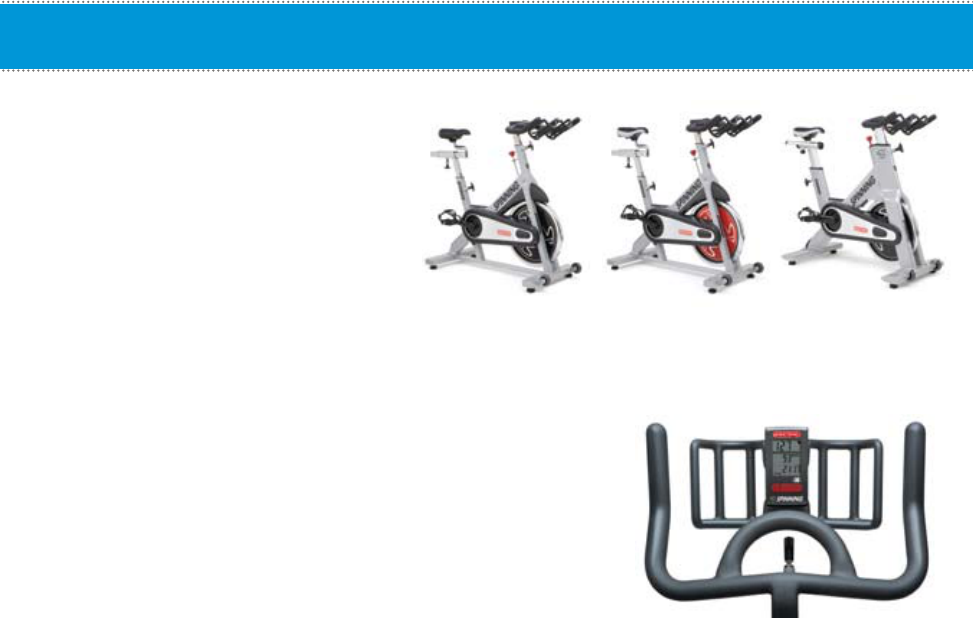
Time required:
• 15 Minutes
Parts required:
• 727-0100 Spinning® Computer Kit
NOTE: The inserts and mounting
bracket are not used on the
Elite 6900 or NXT 7000.
Tools required:
• M5 Allen Wrench
• M2 Allen Wrench
1. Install the mounting bracket to the center flat section of the handlebar
by slightly prying the computer bracket clamp open.
2. Secure clamp down by tightening the M6x20 screw and M6 nut.
Mounting Computer On Handlebars - Pro 7070 / Elite 7080 / NXT 7090 Maintenance Checklist
21

Maintenance Checklist
22
Star Trac strongly recommends performing the regular daily, weekly and monthly preventive maintenance
routines outlined below. If any items need replacement contact the Star Trac Customer Support Department
at 800-503-1221 or 1-714-669-1660.
D= Daily W= Weekly M= Monthly
D W M Procedure
√
√
√
Daily maintenance of the computer will determine its life of the computer by how consistently it is
performed.
• Wipe down the computer with a soft cloth after each use.
• Dilute Simple Green (1) with water (30) (30:1 ratio) spray onto a soft cloth then wipe the Spinner®
Computer.
NOTE: Never spray directly onto the Spinner® Computer.
• Never use abrasive cleaning liquids or oil base, ammonia or alcohol when wiping down the computer.
√
√
The weekly maintenance should focus on the overall performance of the computer. During this portion
of the maintenance look for vibration and possible loose assemblies.
• Inspect each computer for loose parts, bolts and nuts. Adjust as necessary.
• Remove any computers that are not properly mounted and are deemed unsafe.
√
√
√
√
The monthly maintenance check should be a comprehensive inspection of the overall assembly
components of the computer.
• Inspect all areas for proper adjustments
• Inspect all parts to determine damage which will require possible part replacement.
• Battery Low will display when the battery needs replacement. Replace the batteries in the computer
with 4 high quality AA Alkaline batteries such as Duracell or Energizer.
• Inspect the mounting of the cadence sensor and magnet to insure it is intact and working properly.
NOTE: Depending on the amount of use, some procedures may need to be performed more frequently.

• No display
o Press any button.
o Pedal the bike and then press any button.
o Check batteries in computer.
• No heart rate
o Is the user wearing a Ant+ or Polar® compatible HR chest strap?
o Moisten the strap and wear it against the skin.
o The battery in the strap might be low, try another strap.
o Stay in Syncing position for 15 seconds. Note: It may take 15 seconds (or more) for the
computer to obtain a heart rate signal from a chest strap.
o Stop pedaling allow computer to change to summery mode - Hold right key for three (3) seconds,
to reset display, restart pedaling.
• Heart rate drops out
o Rider may not have held forward position for 15 seconds.
o Rider does not have the recommended chest strap or it may not be working.
• Which heart rate strap works with my Spinning® Computer?
o Any Polar® HR strap. Note: It is suggested to use a Polar® “Coded” series
chest strap to reduce HR “crosstalk”.
o Any Ant+ compatible HR Strap
• Picking up another riders heart rate
o Bikes might be too close to each other and receiving HR from another rider. Move the
bikes so there is more space from the computer of your bike to the chest of the other
rider (see diagram on page 5).
o Each rider should wear an Ant+ or Polar® “Coded” series chest strap.
FAQ’s and Troubleshooting FAQ’s and Troubleshooting - cont’d
23

• Battery light does not stay on long enough
o Change the BLON time (see page 6).
• No RPM
o Is the magnet on the left side of the flywheel and aligned with the cadence sensor?
o Sync up the computer and cadence unit and wait 60 seconds.
o Check the battery in the cadence sensor, replace if necessary.
o If pedaling exceeds 120 RPM, the computer will flash the 120 value until rpm’s decrease.
• What is the battery life?
o Computer batteries last approximately 1 year depending on usage and backlight use.
Note: “Low Batt” will be displayed underneath the Heart symbol, suggesting battery replacement.
• Computer batteries: 4 AA Alkaline
• Cadence sensor battery: Lithium CR2032
o Cadence sensor battery lasts approximately 1 year.
• What does the computer display?
o Cadence = RPM
o Heart Rate = BPM
o Total Distance = MILES / KM
o Elapsed Time = MINUTES
o Total Calories = kCal (summary mode only)
FAQ’s and Troubleshooting - cont’d
24

Instructor Education
Cadence, Resistance And Intensity:
Understanding the relationship between cadence, resistance and intensity is the key to Spinning® program
classes that meet training goals. By using the Spinner® computer, you will become more proficient at increasing
power, gaining efficient leg speed and mastering the relationship between ideal resistance and heart rate
intensity.
Heart Rate Monitoring:
Before discussing cadence and how to use the Spinning® Computer effectively, one needs an understanding
of heart rate monitoring. Heart rate monitors are used in the Spinning® program for continuous feedback on
exercise intensity. For effective training, it is desirable sometimes to exercise at anaerobic intensity and aerobic
intensity at some other times. Heart rates are used to tell whether a person is in aerobic or anaerobic intensity.
Generally speaking, when heart rate is between 65 % – 80% of one’s maximum heart rate (MHR) it is aerobic,
and is anaerobic when the heart rate is above 80%. An easy way to estimate one’s maximum heart rate is to
use the age-predicted formula: 220 – age. Subtract one’s age from 220 to get age-predicted maximum heart
rate. For example, a 30 years old has 220 – 30 to get age-predicted maximum heart rate of 190 beats per
minute (BPM).
25
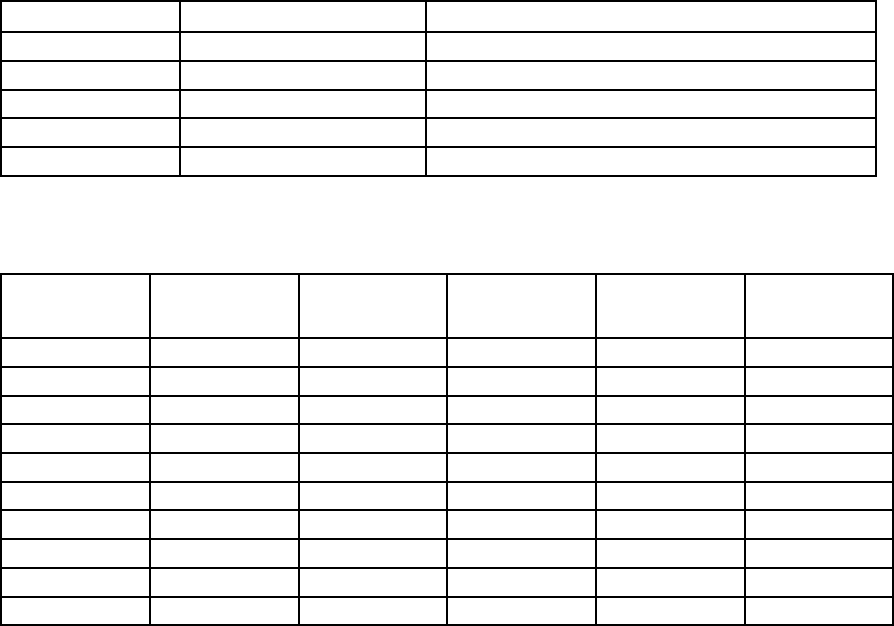
Energy Zones™:
The Spinning® Energy Zones are the foundation of heart rate training in the Spinning® program. Each Energy
Zone™ is a type of training based on exercise intensity (indicated by heart rate).
Energy Zone™Intensity Range Purpose
Recovery 50% to 65% of MHR Relaxation and energy accumulation.
Endurance 65% to 75% of MHR Improves muscular endurance and mental stamina.
Strength 75% to 85% of MHR Raises metabolism, burns fat, increases energy.
Interval 65% to 92% of MHR Trains the heart to recover quickly from work effort.
Race Day 80% to 92% of MHR To challenge the well conditioned exerciser.
ENERGY ZONE™ HEART RATE CHART
AGE RECOVERY
50%-65%
ENDURANCE
65%-75%
STRENGTH
75%-85%
INTERVAL
65%-92%
RACE DAY
80%-92%
20-23 100-129 129-149 149-168 129-182 160-182
24-27 98-126 126-146 146-165 126-178 155-178
28-31 96-123 123-143 143-162 123-175 153-175
32-35 94-120 120-140 140-159 120-172 150-172
36-39 92-118 118-137 137-155 118-168 146-168
40-43 90-116 116-134 134-151 116-164 143-164
44-47 88-113 113-131 131-148 113-161 140-162
48-51 86-110 110-128 128-145 110-157 137-157
52-55 84-108 108-125 125-141 108-153 133-153
56-60 82-105 105-122 122-139 105-150 131-150
26
CADENCE FUNDAMENTALS
What Is Cadence?
Cadence is defined as the number of times the pedals revolve per minute, also known as RPM for revolutions
per minute. The safest, most efficient and most realistic cadences are 80–110 RPM for a flat road and 60–80
RPM for a hill. These ranges are based on studying the cadences of elite cyclists as well as understanding how
the muscles work together to turn the pedals in the most efficient manner.
Cadence Range for Flat Roads: 80-110 RPM.
Pedaling faster than 110 RPM is both unrealistic and counterproductive. The resistance knob on a Spinning® bike
is used to increase friction on the flywheel in order to simulate realistic external forces one would encounter on
an outdoor bike, such as road surfaces, bike weight and wind resistance.
Pedaling Faster Than 110 RPM Is Unrealistic because:
• It’s like pedaling very fast in a very low gear—there’s a low power to resistance ratio.
• It’s wasted energy. If a person pedaled like this on street bike, he/she wouldn’t generate
much power or speed.
• A skilled cyclist who has worked on her pedal stroke for many years and has trained their nervous
system to react quickly is able to pedal efficiently at 100+ rpm for an extended period. Because of
his/her strength and ability to overcome the higher resistance at faster leg speeds, it is said that he/
she has a high power to resistance ratio.
Pedaling Faster Than 110 RPM Is Counterproductive because:
• No amount of high-cadence/low-resistance pedaling on a Spinning® bike will succeed at training
the nervous system properly. The flywheel is doing most of the work.
• One won’t achieve his/her performance and weight loss goals.
• One won’t build leg strength.
27
Is It Good To Pedal Faster Than 110 RPM?
Those who have a high power to resistance ratio may occasionally attain these leg speeds. This means
they have the ability to overcome resistance through strength and speed. The rare, highly skilled Spinning®
enthusiast (often cyclists) who have mastered a smooth pedal stroke and who understand the dynamics of
cadence can pedal faster than 110 rpm for 1-3 minutes. A high performance sprint, used judiciously in ride
profiles may require cadences over 110 rpm for 10-20 seconds.
Bouncing In The Saddle:
When riding at cadences of 100-120 rpm with too little resistance, the rider will bounce in the saddle. What
causes the bouncing has to do with the pedal stroke. There are four phases to the pedal stroke. Many riders,
however, usually have only one phase—straight down. That means that they haven’t perfected sweeping the
foot back at the bottom of the pedal stroke and pushing the toe forward at the top. As a result, they push down
furiously on the pedals and rely on the flywheel to carry their foot the rest of the way. When their foot reaches
the bottom of the crank arm, the leg can go no further, and the hip is raised up off the saddle, creating that
familiar bouncing. The short-term solution is to add more resistance, but one must also work on pedal stroke
technique and cadence drills.
Cadence Range For Hills: 60-80 rpm
Since 1998, Lance Armstrong has amazed the cycling world with his ability to pedal at 90 RPM up some
of Europe’s toughest climbs. But keep in mind that Lance can ride at 400 watts for several hours and stay
aerobic (watts is a measure of power; 400 watts is a lot of power), whereas many skilled cyclists may be
lucky to achieve 400 watts for a few minutes. In order to pedal at 90 RPM up a steep hill, one must either be
superhuman or must choose a gear that is so low (granny gear), that the bike barely moves. The granny gear
is the small cog found on the front chain ring of mountain bikes and some road bikes—it allows the rider to
climb hills at a much higher cadence and lower resistance, but his/her power and speed are reduced.
28
It’s not dangerous to exceed 80 RPM on a hill, but for extended periods it will likely raise the rider’s intensity too
high and won’t achieve the strength benefits of climbing. It is all right to exceed 80 RPM for brief periods, such
as in a standing climb for the last 10-20 seconds. The rider intensity will increase dramatically, so make sure one
has planned for this in his/her profile.
The lower limit of 60 RPM on a hill is for safety reasons. There won’t be many situations where a cyclist will
pedal slower than 60 RPM. If one cannot turn the cranks at a faster cadence than 60 RPM the resistance is too
high. A key indicator is the need to contort the body by throwing his weight into pushing the pedal downward
while pulling on the handlebars. This excessive resistance places too much load on the knee joint and puts the
hips and low back at risk. One wouldn’t perform a bicep curl with a weight that would require the rider to throw
his/her hips forward. The same applies to resistance while pedaling. A rider must build the strength in his legs
using appropriate resistance at a cadence no lower than 60 RPM. If a steep hill is the goal, find the highest
amount of resistance one can maintain while employing good form at 60 RPM without contorting the body to
turn the pedals. Remember, 60 RPM is one revolution of the pedals per second.
29
30
Tips For Choosing An Appropriate Cadence And Resistance:
• Warm-Up. The first ten minutes of a Spinning® ride are critical for establishing proper cadence.
With no resistance during warm-up, one may tend to pedal too quickly thus raising the heart rates
prematurely. During the warm-up, it’s important to work on cadence by keeping intensity under
control (65% or less). Use the warm-up to establish a smooth cadence and gradually establish a
balanced intensity. Similarly, after the warm-up, be cautious of increasing cadence over 100 rpm
with light resistance (this will also cause a potential anaerobic event and one may spend
the remaining class time attempting to recover). In other words, if one chooses to climb after the
warm-up, ensure that intensity and cadence are increasing equally.
• Resistance. Resistance is good. Some riders are afraid to add resistance because they think they’ll
end up with bulging quadriceps. But in cycling, it is the sprinters who have the larger quadriceps
(high cadences, lower resistance), and the skilled climbers generally have the longer, leaner
legs (lower cadences, higher resistance).
• Intensity. Slower cadence does not necessarily mean lower intensity. Perhaps a rider feels that if he/
she slows down the rpm his/her heart rate will drop too low. But in fact, he/she is in control of
the intensity because he/she can add resistance as needed. Subtle turns of the knob should
eventually generate the required response. Wearing a heart rate strap is critical to monitor ones
intensity goals using the right combination of cadence and resistance.
• Putting it together. Cadence and resistance are inversely related. The next section will explain how
cadence and resistance work together to elicit a given intensity. With this understanding, one can
coach others to select the appropriate resistance and cadence for the terrain they have selected.
The Relationship Between Cadence And Resistance:
Cadence, resistance and intensity are interrelated. For any given intensity, there is a correlated cadence and
resistance combination. In other words, if one knows the intensity (heart rate) he/she wants to exercise at, and
selects the cadence at which to ride, he/she can find the right resistance to get to that intensity. Or if given a
target intensity and target cadence, one can dial in the right amount of resistance.
In other words, for every selected cadence parameter combined with a heart rate range, one should be able
to find a resistance that will attain that heart rate. The goal is to find that resistance through experimentation.
Remember that on some days the resistance may be slightly different than other days due to factors such as
fatigue, stress, overtraining, or medication.
Applying The Concept:
The following examples will help the rider to understand and learn to apply this relationship between cadence,
heart rate and intensity.
1. Ride at a steady state heart rate of 75% maximal heart rate (MHR) on a flat road, at a cadence in
the range of 85–95 RPM. Dial in the amount of resistance necessary to reach that goal.
2. Now find a moderate to hard seated climb at a cadence of 65-70 RPM and at a high-end aerobic
HR of around 80% MHR (a range is sufficient). Dial in the right amount of resistance to reach
that goal.
3. Now suppose the hill just became a little easier, but one wants to maintain the same HR of 80%.
Because it’s still a hill, his/her cadence should not rise above 80 RPM. What does one need to do to
stay at the same intensity as cadence increases? Answer: reduce the resistance just a little.
31
32
4. Find a tough climb without exceeding 85% MHR. Continue adding resistance until one feels the need to rise
out of the saddle in a standing climb. (Outdoors, cyclists stand on a climb when the road becomes steeper.)
Maintain a cadence of 70–75 RPM. Play with these three variables, finding the right combination to meet the
parameters. If cadence picks up too fast, one will have to increase the resistance. If heart rate rises too high,
one will need to adjust one or both of the other variables (cadence and/or resistance).
These exercises will help a rider become the master of the road and in control of his/her intensity. Instead of
being told to turn the resistance knob a particular number of rotations, one will be able to find the appropriate
resistance for the cadence and intensity desired.
CADENCE DRILLS
Now let’s look at some specific cadence drills which one can incorporate into his/her rides
Cadence Drill #1: Teaching The Concept Of Cadence Vs. Resistance
This drill introduces the relationship between cadence, resistance and intensity. The goal is to maintain the
same intensity even though the terrain changes. An outdoor cyclist would accomplish this by changing gears.
Begin on a flat road and ride at an intensity of 80% MHR and a cadence of 85 RPM for 5 minutes (this will allow
you to internalize the feel of the cadence and resistance). Ride at 85, 90 and 95 RPM for 3-4 minutes each, all
the while maintaining the same heart rate. If at any point one cannot maintain the intensity, he/she should ride
at the last cadence to maintain the desired intensity which could mean to go back down the ladder from 95 to
80 RPM.
Next, add a little hill while maintaining the same intensity. Remain seated and ride a progressively steeper hill
by gradually adding resistance every 3-4 minutes. Try to maintain the same intensity of 80%. In order to do so,
one will have to slow his/her legs down as the hill becomes steeper. Ride at 80, 75, 70, 65 and 60 RPM. If one
cannot maintain the intensity he/she should ride at the last cadence where he/she could.
Now for the hard part—transition to a standing climb. Once standing, ride back up the ladder from 60 to
80 RPM, reducing the resistance slightly each time. It will be difficult to maintain the 80% MHR as the hill
becomes less steep because heart rate often rises with faster cadences on a hill. Take caution to find the
correct amount of resistance (one that allows the rider to maintain the desired cadence) while at the same time
staying connected to the crank arms (no jerky pedal strokes). On this drill, reduce the time spent at each level to
1 minute each.
Bounce Test:
This drill introduces a basic and reliable method for determining your maximum cadence and also helps one
determine the highest cadence where one can safely and efficiently pedal without bouncing in the saddle.
Skilled riders can achieve a higher cadence, which will help train leg speed. With training and focus, one can
improve skill and leg speed.
Select a flat road resistance at an aerobic intensity of 70-75% of MHR. Gradually increase the cadence from
80 to 100 RPM about 3 RPM every minute, all on a flat road. One can make subtle adjustments to his/her
resistance if needed. Intensity will undoubtedly increase, but one should hit maximum cadence before reaching
an anaerobic intensity. Stay seated deeply into the saddle while pedaling. Pull the feet back at the bottom and
push forward at the top of the pedal stroke.
If one start to bounce, reduce the cadence a few RPM to determine the exact point one can ride without
bouncing. One will probably need to raise the resistance slightly.
33
34
Ladders:
Ladders are a progressive increase or decrease in one of the following variables: cadence, resistance or
intensity. This drill is best employed using seated or standing flats and seated or standing climbs. Jumps do not
work well for ladders. One can use a combination of the following drills in any profile:
• Constant cadence with increasing resistance in a seated at or standing at. The terrain gradually
becomes a hill.
• Constant resistance with increasing cadence, in a seated or standing position. Intensity can increase
very quickly, so this requires close attention to your heart rate monitor. This drill is also known as
spin-ups or accelerations (see below).
• Measured heart rate increases (5 beats at a time) using a combination of cadence or resistance to
elicit the increase in intensity. This is an excellent tool to practice control.
Accelerations (Spin-Ups)
Accelerations (also known as Spin-Ups) are a type of ladder where riders progressively increase the cadence
over a fairly short period of time. This drill requires a long warm-up. Accelerations are done in intervals and can
be quite intense, but they’re an excellent way to train leg speed and improve muscle firing patterns in the legs.
It also trains muscular endurance on hills. Accelerations help the rider to move beyond the cadence where he/
she tends to bounce.
These drills are done in intervals with ample recovery in between. The work to rest ratio should be at least 1:2
or even 1:3. This guarantees that when one begins the next interval, he/she is rested enough to give it his/her
all. Insufficient recovery will hamper the ability to perform the work interval.
On the Flats: Establish a flat road resistance at 80 RPM at an aerobic intensity. The first drill will be for 90
seconds, progressively raising the cadence to 110 RPM. Every 10-12 seconds, raise cadence by 2-3 RPM.
As one approaches and surpasses 100 RPM, extra effort should be made to stay seated deeply in the saddle
without bouncing (if one cannot do this without bouncing, he/she should not go beyond that point—it will defeat
the purpose).
Next, try this over 60 seconds, raising the cadence 2 RPM every 4 seconds.
Seated Climbs: Climb at 60 RPM with enough resistance to bring the intensity to 75%. Gradually increase the
cadence to 80 RPM over 60 seconds. If possible, use 85% MHR as a ceiling. One may have to try this several
times to find a hill that allows him/her to stay within the desired intensity. Once reaching 80 RPM, hold this
cadence for progressively longer periods. (15, 30, 45 and 60 seconds).
Standing Climbs: Begin at 60 RPM and gradually increase the cadence to 80 RPM. Intensity will no doubt rise
quickly, so limit the intervals to 45–60 seconds.
35
36
This page intentionally left blank
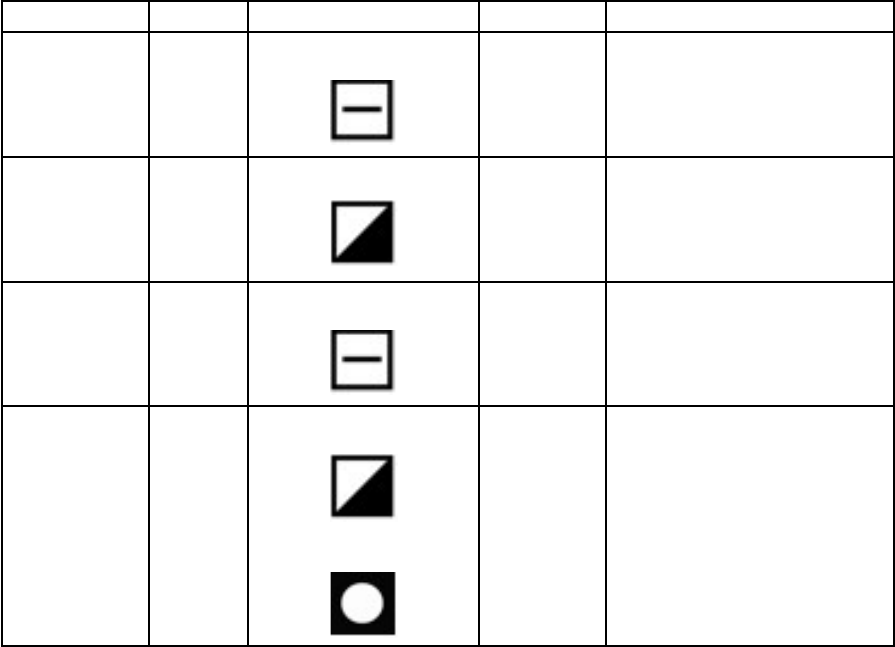
Spinning® Ride Profile:
This Strength Energy Zone™ ride takes a rider on three hills, each one a little longer, steeper and therefore more
difficult. For the first hill, attempt to keep the heart rate at 80% max. Allow heart rate to rise to 85% with the
second and third hills.
Elapsed Time Duration Movement/Cadence Intensity Technique
0:00 – 5:00 5 min Seated Flat
80-110 RPM
50-65% MHR Warm up for 5 minutes and allow
heart rate to rise up to 65% MHR.
5:00 – 9:00 4 min Seated Climb
80 RPM
80% MHR Settle in to the back of the saddle as
you gradually add resistance and take
your cadence to 80 RPM.
9:00 – 12:00 3 min Seated Flat
90-100 RPM
75% MHR Unload resistance and increase
cadence to 90-100 RPM. Find the
right resistance to maintain a heart
rate effort at 75%.
12:00 – 20:00 8 min Seated Climb
60-80 RPM
Jumps on a Hill
60-80 RPM
80-85% MHR Add resistance to moderate/heavy
and combine the two movements
in any combination. Example: 3 min
seated climb, 1 min jumps on a hill,
repeat
37
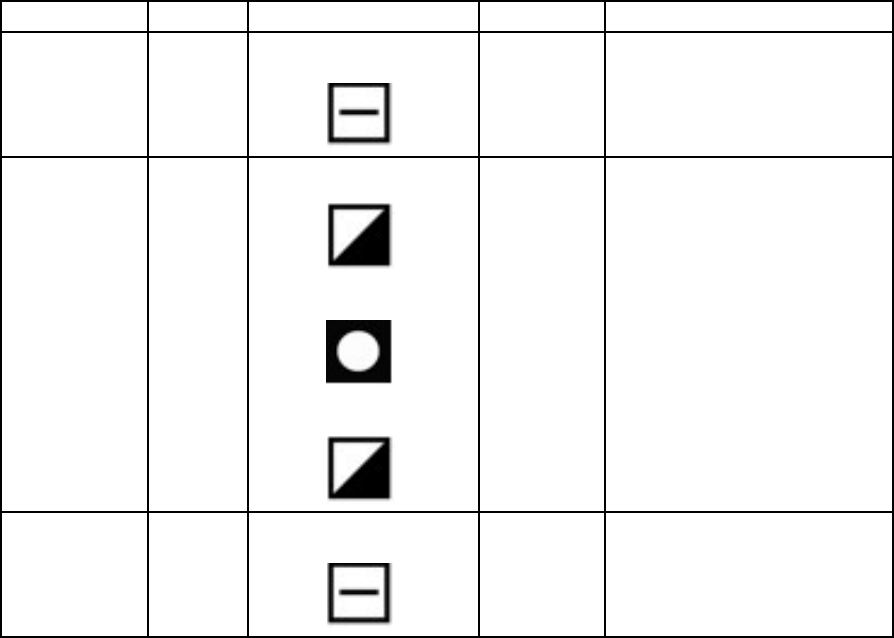
Elapsed Time Duration Movement/Cadence Intensity Technique
20:00 – 23:00 5 min Seated Flat
90-100 RPM
75% MHR Unload resistance and increase ca-
dence to 90-100 RPM. Find the right
resistance to maintain a heart rate
effort at 75%.
23:00 – 35:00 12 min Seated Climb
60-80 RPM
Jumps on a Hill
60-80 RPM
Standing Climb
60-80 RPM
80-85 MHR Add resistance to moderate/heavy
and combine all three movements
in any combination. Example: 2 min
seated, 1 min jumps, 2 min standing,
3 min seated, 2 min jumps, 2 min
standing.
35:00 – 40:00 5 min Seated Flat
80-110 RPM
50-65% MHR Decrease resistance to light and allow
HR to come down to 50-65%.
38

39
FCC Statement
This equipment has been tested and found to comply with the limits for a Class B digital device, pursuant
to part 15 of the FCC rules. These limits are designed to provide reasonable protection against harmful
interference in a residential installation. This equipment generates, uses and can radiate radio frequency
energy and, if not installed and used in accordance with the instructions, may cause harmful interference
to radio communications. However, there is no guarantee that interference will not occur in a particular
installation. If this equipment does cause harmful interference
to radio or television reception, which can be determined by turning the equipment off and on, the user is
encouraged to try to correct the interference by one or more of the following measures:
-Reorient or relocate the receiving antenna.
-Increase the separation between the equipment and receiver.
-Connect the equipment into an outlet on a circuit different from that to which the receiver is connected.
-Consult the dealer or an experienced radio/TV technician for help.
To assure continued compliance, any changes or modifications not expressly approved by the party
responsible for compliance could void the user’s authority to operatethis equipment. (Example- use only
shielded interface cables when connectingto computer or peripheral devices).
This equipment complies with Part 15 of FCC RF Rules. Operation is subject to the following two
conditions:
1) This device may not cause interference and
2) This device must accept any interference, including interference that may cause undesired operation of
the device.
Caution!
The manufacturer is not responsible for any radio or TV interference caused by unauthorized
modifications to this equipment. Such modifications could void the user auhority to operate the
equipment.
For IC
Canada Statement
This Device complies with RSS-210 of the IC Rules; Operation is subject to the following two conditions:
(1). This device may not cause interference and
(2). This device must accept any interference received,, including interference that may cause undesired operation.
L'utilisation de ce dispositif est autorisée seulement aux deux conditions suivantes :
(1) il ne doit pas produire de brouillage, et
(2) l'utilisateur du dispositif doit être prêt à accepter tout brouillage radioélectrique reçu, même si ce brouillage est
susceptible de compromettre le fonctionnement du dispositif.
40
This page intentionally left blank

©2009 Star Trac. All Rights Reserved. Star Trac and the Star Trac
logo are registered trademarks of Unisen, Inc. Expect Different
is a trademark of Unisen, Inc. SPIN®, Spinning®, Spinner®, the
Spinning® logo and eSpinner® are registered trademarks of Mad
Dogg Athletics, Inc.
For more information on Spinning® education, events,
accessories and apparel log onto www.spinning.com.
For more information on Star Trac products and support
visit http://support.startrac.com or call 800-503-1221.
Spinning® Computer Manual
620-7654 Rev H